Optimizing Agroecological Measures for Climate-Resilient Olive Farming in the Mediterranean
Abstract
1. Introduction
2. Results and Discussion
2.1. Effect on Soil Water Content
2.2. Effect of the Agroecological Practices on pH and EC
2.3. Effect of the Agroecological Practices on SOM
2.4. Effect of the Agroecological Practices on Soil Nutrients
3. Materials and Methods
3.1. Study Site
3.2. Experimental Design
3.3. Soil Sampling and Analysis
3.4. Statistical Analysis
4. Conclusions
Author Contributions
Funding
Data Availability Statement
Conflicts of Interest
References
- White, J.W.; Hoogenboom, G.; Kimball, B.A.; Wall, G.W. Methodologies for Simulating Impacts of Climate Change on Crop Production. Field Crops Res. 2011, 124, 357–368. [Google Scholar] [CrossRef]
- Koubouris, G. Advances in Prediction, Monitoring and Mitigation of Climate Change Effects on Water Resources and Good Agricultural Practices for Crop Adaptation to Environmental Stresses. J. Water Clim. Chang. 2018, 9, 631–632. [Google Scholar] [CrossRef]
- Plan, M.A. Mediterranean Strategy for Sustainable Development 2016–2025: Investing in Environmental Sustainability to Achieve Social and Economic Development; Plan Bleu, Regional Activity Centre: Valbonne, France, 2016. [Google Scholar]
- Giorgi, F. Climate Change Hot-spots. Geophys. Res. Lett. 2006, 33, 2006GL025734. [Google Scholar] [CrossRef]
- Fraga, H.; Moriondo, M.; Leolini, L.; Santos, J.A. Mediterranean Olive Orchards under Climate Change: A Review of Future Impacts and Adaptation Strategies. Agronomy 2020, 11, 56. [Google Scholar] [CrossRef]
- Rodrigo-Comino, J.; Salvia, R.; Quaranta, G.; Cudlín, P.; Salvati, L.; Gimenez-Morera, A. Climate Aridity and the Geographical Shift of Olive Trees in a Mediterranean Northern Region. Climate 2021, 9, 64. [Google Scholar] [CrossRef]
- Giorgi, F.; Jones, C.; Asrar, G.R. Addressing Climate Information Needs at the Regional Level: The CORDEX Framework. World Meteorol. Organ. (WMO) Bull. 2009, 58, 175. [Google Scholar]
- Nogherotto, R.; Raffaele, F. Future Projections of the Fire Weather Index (FWI) Using CORDEX-CORE and CMIP5 and CMIP6 Simulations. In Proceedings of the EGU General Assembly Conference Abstracts, Vienna, Austria, 23–27 May 2022. [Google Scholar]
- Intergovernmental Panel On Climate Change (Ed.) Climate Change 2013—The Physical Science Basis: Working Group. I Contribution to the Fifth Assessment Report of the Intergovernmental Panel on Climate Change, 1st ed.; Cambridge University Press: Cambridge, UK, 2014; ISBN 978-1-107-05799-9. [Google Scholar]
- Moriondo, M.; Bindi, M. Impact of Climate Change on the Phenology of Typical Mediterranean Crops. Ital. J. Agrometeorol. 2007, 3, 5–12. [Google Scholar]
- Tumwesigye, W.; Kishoin, V.; Turyasingura, B.; Mwanjalolo Jackson-Gilbert, M. Landscape Diversity Enhances Climate Change Resilience: A Review. Int. Res. J. Multidiscip. Technovation 2022, 8–17. [Google Scholar] [CrossRef]
- Hamidov, A.; Helming, K.; Bellocchi, G.; Bojar, W.; Dalgaard, T.; Ghaley, B.B.; Hoffmann, C.; Holman, I.; Holzkämper, A.; Krzeminska, D.; et al. Impacts of Climate Change Adaptation Options on Soil Functions: A Review of European Case-studies. Land. Degrad. Dev. 2018, 29, 2378–2389. [Google Scholar] [CrossRef]
- Mondal, S.; Sallam, A.; Sehgal, D.; Sukumaran, S.; Farhad, M.; Navaneetha Krishnan, J.; Kumar, U.; Biswal, A. Advances in Breeding for Abiotic Stress Tolerance in Wheat. In Genomic Designing for Abiotic Stress Resistant Cereal Crops; Kole, C., Ed.; Springer International Publishing: Cham, Switzerland, 2021; pp. 71–103. ISBN 978-3-030-75874-5. [Google Scholar]
- Skendžić, S.; Zovko, M.; Živković, I.P.; Lešić, V.; Lemić, D. The Impact of Climate Change on Agricultural Insect Pests. Insects 2021, 12, 440. [Google Scholar] [CrossRef] [PubMed]
- Pergola, M.; Favia, M.; Palese, A.M.; Perretti, B.; Xiloyannis, C.; Celano, G. Alternative Management for Olive Orchards Grown in Semi-Arid Environments: An Energy, Economic and Environmental Analysis. Sci. Hortic. 2013, 162, 380–386. [Google Scholar] [CrossRef]
- Nacima, D.D.; Deghiche, L.; Belhamra, Y. Etude Ecologique et Statistique de L’entomofaune des Oasis Des Ziban. Int. J. Hum. Settl. 2021, 5, 2021. [Google Scholar]
- Rapoport, H.F.; Fabbri, A.; Sebastiani, L. Olive Biology. In The Olive Tree Genome; Rugini, E., Baldoni, L., Muleo, R., Sebastiani, L., Eds.; Compendium of Plant Genomes; Springer International Publishing: Cham, Switzerland, 2016; pp. 13–25. ISBN 978-3-319-48886-8. [Google Scholar]
- Chartzoulakis, K.; Psarras, G. Global Change Effects on Crop Photosynthesis and Production in Mediterranean: The Case of Crete, Greece. Agric. Ecosyst. Environ. 2005, 106, 147–157. [Google Scholar] [CrossRef]
- Di Paola, A.; Chiriacò, M.V.; Di Paola, F.; Nieddu, G. A Phenological Model for Olive (Olea europaea L. var europaea) Growing in Italy. Plants 2021, 10, 1115. [Google Scholar] [CrossRef] [PubMed]
- Mairech, H.; López-Bernal, Á.; Moriondo, M.; Dibari, C.; Regni, L.; Proietti, P.; Villalobos, F.J.; Testi, L. Sustainability of Olive Growing in the Mediterranean Area under Future Climate Scenarios: Exploring the Effects of Intensification and Deficit Irrigation. Eur. J. Agron. 2021, 129, 126319. [Google Scholar] [CrossRef]
- Jarecki, M.K.; Lal, R. Crop Management for Soil Carbon Sequestration. Crit. Rev. Plant Sci. 2003, 22, 471–502. [Google Scholar] [CrossRef]
- Gomez, J.; Sobrinho, T.; Giraldez, J.; Fereres, E. Soil Management Effects on Runoff, Erosion and Soil Properties in an Olive Grove of Southern Spain. Soil Tillage Res. 2009, 102, 5–13. [Google Scholar] [CrossRef]
- Basche, A.D.; Kaspar, T.C.; Archontoulis, S.V.; Jaynes, D.B.; Sauer, T.J.; Parkin, T.B.; Miguez, F.E. Soil Water Improvements with the Long-Term Use of a Winter Rye Cover Crop. Agric. Water Manag. 2016, 172, 40–50. [Google Scholar] [CrossRef]
- Michalopoulos, G.; Kasapi, K.A.; Koubouris, G.; Psarras, G.; Arampatzis, G.; Hatzigiannakis, E.; Kavvadias, V.; Xiloyannis, C.; Montanaro, G.; Malliaraki, S.; et al. Adaptation of Mediterranean Olive Groves to Climate Change through Sustainable Cultivation Practices. Climate 2020, 8, 54. [Google Scholar] [CrossRef]
- Amundson, R.; Berhe, A.A.; Hopmans, J.W.; Olson, C.; Sztein, A.E.; Sparks, D.L. Soil and Human Security in the 21st Century. Science 2015, 348, 1261071. [Google Scholar] [CrossRef]
- Lal, R.; Delgado, J.A.; Groffman, P.M.; Millar, N.; Dell, C.; Rotz, A. Management to Mitigate and Adapt to Climate Change. J. Soil Water Conserv. 2011, 66, 276–285. [Google Scholar] [CrossRef]
- Kourgialas, N.; Psarras, G.; Morianou, G.; Pisinaras, V.; Koubouris, G.; Digalaki, N.; Malliaraki, S.; Aggelaki, K.; Motakis, G.; Arampatzis, G. Good Agricultural Practices Related to Water and Soil as a Means of Adaptation of Mediterranean Olive Growing to Extreme Climate-Water Conditions. Sustainability 2022, 14, 13673. [Google Scholar] [CrossRef]
- Rezazga, A.; Ruiz, C.; Montanaro, G.; Falcone, G.; Koubouris, G. Driving the Ecological Transition of Agriculture through Voluntary Certification of Environmental Impacts: An Exploratory Literature Review on the Olive-Oil Sector. Sustainability 2024, 16, 1227. [Google Scholar] [CrossRef]
- Haruna, S.I.; Nkongolo, N.V. Cover Crop Management Effects on Soil Physical and Biological Properties. Procedia Environ. Sci. 2015, 29, 13–14. [Google Scholar] [CrossRef]
- Kaye, J.P.; Quemada, M. Using Cover Crops to Mitigate and Adapt to Climate Change. A Review. Agron. Sustain. Dev. 2017, 37, 4. [Google Scholar] [CrossRef]
- Kaspar, T.C.; Singer, J.W. The Use of Cover Crops to Manage Soil. In Soil Management: Building a Stable Base for Agriculture; Hatfield, J.L., Sauer, T.J., Eds.; Soil Science Society of America: Madison, WI, USA, 2015; pp. 321–337. ISBN 978-0-89118-195-8. [Google Scholar]
- McDaniel, M.D.; Tiemann, L.K.; Grandy, A.S. Does Agricultural Crop Diversity Enhance Soil Microbial Biomass and Organic Matter Dynamics? A Meta-analysis. Ecol. Appl. 2014, 24, 560–570. [Google Scholar] [CrossRef]
- Daigh, A.L.; Zhou, X.; Helmers, M.J.; Pederson, C.H.; Ewing, R.; Horton, R. Subsurface Drainage Flow and Soil Water Dynamics of Reconstructed Prairies and Corn Rotations for Biofuel Production. Vadose Zone J. 2014, 13, 1–11. [Google Scholar] [CrossRef]
- Li, Y.; Tian, D.; Feng, G.; Yang, W.; Feng, L. Climate Change and Cover Crop Effects on Water Use Efficiency of a Corn-Soybean Rotation System. Agric. Water Manag. 2021, 255, 107042. [Google Scholar] [CrossRef]
- Oudart, D.; Robin, P.; Paillat, J.M.; Paul, E. Modelling Nitrogen and Carbon Interactions in Composting of Animal Manure in Naturally Aerated Piles. Waste Manag. 2015, 46, 588–598. [Google Scholar] [CrossRef] [PubMed]
- Singh, R.; Singh, G.S. Traditional Agriculture: A Climate-Smart Approach for Sustainable Food Production. Energ. Ecol. Environ. 2017, 2, 296–316. [Google Scholar] [CrossRef]
- Scarpato, D.; Simeone, M. Euro-Mediterranean Integration and Competitiveness of the Agro-Food Sector. An Empirical Analysis in Campania Region. New Medit Mediterr. J. Econ. Agric. Environ. Rev. Méditerranéenne Dʹeconomie Agric. Et Environ. 2013, 12, 56. [Google Scholar]
- Neher, D.A.; Weicht, T.R.; Bates, S.T.; Leff, J.W.; Fierer, N. Changes in Bacterial and Fungal Communities across Compost Recipes, Preparation Methods, and Composting Times. PLoS ONE 2013, 8, e79512. [Google Scholar] [CrossRef] [PubMed]
- Proietti, P.; Calisti, R.; Gigliotti, G.; Nasini, L.; Regni, L.; Marchini, A. Composting Optimization: Integrating Cost Analysis with the Physical-Chemical Properties of Materials to Be Composted. J. Clean. Prod. 2016, 137, 1086–1099. [Google Scholar] [CrossRef]
- Spaccini, R.; Piccolo, A. Molecular Characteristics of Humic Acids Extracted from Compost at Increasing Maturity Stages. Soil Biol. Biochem. 2009, 41, 1164–1172. [Google Scholar] [CrossRef]
- Nasini, L.; Gigliotti, G.; Balduccini, M.A.; Federici, E.; Cenci, G.; Proietti, P. Effect of Solid Olive-Mill Waste Amendment on Soil Fertility and Olive (Olea europaea L.) Tree Activity. Agric. Ecosyst. Environ. 2013, 164, 292–297. [Google Scholar] [CrossRef]
- Hodge, S.; Conway, J. The Effects of Insect Frass Fertilizer and Biochar on the Shoot Growth of Chicory and Plantain, Two Forage Herbs Commonly Used in Multispecies Swards. Agronomy 2022, 12, 2459. [Google Scholar] [CrossRef]
- Watson, C.; Preißing, T.; Wichern, F. Plant Nitrogen Uptake From Insect Frass Is Affected by the Nitrification Rate as Revealed by Urease and Nitrification Inhibitors. Front. Sustain. Food Syst. 2021, 5, 721840. [Google Scholar] [CrossRef]
- Poveda, J. Insect Frass in the Development of Sustainable Agriculture. A Review. Agron. Sustain. Dev. 2021, 41, 5. [Google Scholar] [CrossRef]
- Barragán-Fonseca, K.Y.; Nurfikari, A.; Van De Zande, E.M.; Wantulla, M.; Van Loon, J.J.A.; De Boer, W.; Dicke, M. Insect Frass and Exuviae to Promote Plant Growth and Health. Trends Plant Sci. 2022, 27, 646–654. [Google Scholar] [CrossRef]
- Poveda, J.; Jiménez-Gómez, A.; Saati-Santamaría, Z.; Usategui-Martín, R.; Rivas, R.; García-Fraile, P. Mealworm Frass as a Potential Biofertilizer and Abiotic Stress Tolerance-Inductor in Plants. Appl. Soil Ecol. 2019, 142, 110–122. [Google Scholar] [CrossRef]
- Schmitt, E.; De Vries, W. Potential Benefits of Using Hermetia Illucens Frass as a Soil Amendment on Food Production and for Environmental Impact Reduction. Curr. Opin. Green. Sustain. Chem. 2020, 25, 100335. [Google Scholar] [CrossRef]
- Aguilera, E.; Guzmán, G.; Alonso, A. Greenhouse Gas Emissions from Conventional and Organic Cropping Systems in Spain. I. Herbaceous Crops. Agron. Sustain. Dev. 2015, 35, 713–724. [Google Scholar] [CrossRef]
- Bechara, E.; Papafilippaki, A.; Doupis, G.; Sofo, A.; Koubouris, G. Nutrient Dynamics, Soil Properties and Microbiological Aspects in an Irrigated Olive Orchard Managed with Five Different Management Systems Involving Soil Tillage, Cover Crops and Compost. J. Water Clim. Chang. 2018, 9, 736–747. [Google Scholar] [CrossRef]
- García-Ruiz, R.; Ochoa, M.V.; Hinojosa, M.B.; Gómez-Muñoz, B. Improved Soil Quality after 16 Years of Olive Mill Pomace Application in Olive Oil Groves. Agron. Sustain. Dev. 2012, 32, 803–810. [Google Scholar] [CrossRef]
- Devarajan, N.; McGarvey, J.A.; Scow, K.; Jones, M.S.; Lee, S.; Samaddar, S.; Schmidt, R.; Tran, T.D.; Karp, D.S. Cascading Effects of Composts and Cover Crops on Soil Chemistry, Bacterial Communities and the Survival of Foodborne Pathogens. J. Appl. Microbiol. 2021, 131, 1564–1577. [Google Scholar] [CrossRef]
- Casacchia, T.; Sofo, A.; Zelasco, S.; Perri, E.; Toscano, P. In Situ Olive Mill Residual Co-Composting for Soil Organic Fertility Restoration and by-Product Sustainable Reuse. Ital. J. Agronomy 2012, 7, 23. [Google Scholar] [CrossRef]
- Diacono, M.; Montemurro, F. Long-Term Effects of Organic Amendments on Soil Fertility. In Sustainable Agriculture Volume 2; Lichtfouse, E., Hamelin, M., Navarrete, M., Debaeke, P., Eds.; Springer Netherlands: Dordrecht, The Netherlands, 2011; pp. 761–786. ISBN 978-94-007-0393-3. [Google Scholar]
- Zhao, W.; Cui, Z.; Zhang, J.; Jin, J. Temporal Stability and Variability of Soil-Water Content in a Gravel-Mulched Field in Northwestern China. J. Hydrol. 2017, 552, 249–257. [Google Scholar] [CrossRef]
- Manns, H.R.; Parkin, G.W.; Martin, R.C. Evidence of a Union between Organic Carbon and Water Content in Soil. Can. J. Soil Sci. 2016, 96, 305–316. [Google Scholar] [CrossRef]
- Panagea, I.S.; Berti, A.; Čermak, P.; Diels, J.; Elsen, A.; Kusá, H.; Piccoli, I.; Poesen, J.; Stoate, C.; Tits, M.; et al. Soil Water Retention as Affected by Management Induced Changes of Soil Organic Carbon: Analysis of Long-Term Experiments in Europe. Land 2021, 10, 1362. [Google Scholar] [CrossRef]
- Zhao, X.; Liu, P.; Feng, Y.; Zhang, W.; Njoroge, B.; Long, F.; Zhou, Q.; Qu, C.; Gan, X.; Liu, X. Changes in Soil Physico-Chemical and Microbiological Properties During Natural Succession: A Case Study in Lower Subtropical China. Front. Plant Sci. 2022, 13, 878908. [Google Scholar] [CrossRef] [PubMed]
- Abiven, S.; Menasseri, S.; Chenu, C. The Effects of Organic Inputs over Time on Soil Aggregate Stability—A Literature Analysis. Soil Biol. Biochem. 2009, 41, 1–12. [Google Scholar] [CrossRef]
- Strudley, M.; Green, T.; Ascoughii, J. Tillage Effects on Soil Hydraulic Properties in Space and Time: State of the Science. Soil Tillage Res. 2008, 99, 4–48. [Google Scholar] [CrossRef]
- Udawatta, R.P.; Anderson, S.H.; Gantzer, C.J.; Garrett, H.E. Influence of Prairie Restoration on CT-Measured Soil Pore Characteristics. J. Environ. Qual. 2008, 37, 219–228. [Google Scholar] [CrossRef] [PubMed]
- Schulten, H.-R.; Schnitzer, M. Chemical Model Structures for Soil Organic Matter and Soils. Soil Sci. 1997, 162, 115–130. [Google Scholar] [CrossRef]
- Bachmann, J.; Guggenberger, G.; Baumgartl, T.; Ellerbrock, R.H.; Urbanek, E.; Goebel, M.; Kaiser, K.; Horn, R.; Fischer, W.R. Physical Carbon-sequestration Mechanisms under Special Consideration of Soil Wettability. J. Plant Nutr. Soil Sci. 2008, 171, 14–26. [Google Scholar] [CrossRef]
- Bhadha, J.H.; Capasso, J.M.; Khatiwada, R.; Swanson, S.; LaBorde, C. Raising Soil Organic Matter Content to Improve Water Holding Capacity. EDIS 2017, 2017, ss661–ss2017. [Google Scholar] [CrossRef]
- Manivannan, S.; Balamurugan, M.; Parthasarathi, K.; Gunasekaran, G.; Ranganathan, L. Effect of Vermicompost on Soil Fertility and Crop Productivity-Beans (Phaseolus vulgaris). J. Environ. Biol. 2009, 30, 275–281. [Google Scholar] [PubMed]
- Bodner, G.; Leitner, D.; Kaul, H.-P. Coarse and Fine Root Plants Affect Pore Size Distributions Differently. Plant Soil 2014, 380, 133–151. [Google Scholar] [CrossRef]
- Hao, H.; Wei, Y.; Cao, D.; Guo, Z.; Shi, Z. Vegetation Restoration and Fine Roots Promote Soil Infiltrability in Heavy-Textured Soils. Soil Tillage Res. 2020, 198, 104542. [Google Scholar] [CrossRef]
- Montanaro, G.; Dichio, B.; Briccoli Bati, C.; Xiloyannis, C. Soil Management Affects Carbon Dynamics and Yield in a Mediterranean Peach Orchard. Agric. Ecosyst. Environ. 2012, 161, 46–54. [Google Scholar] [CrossRef]
- Montanaro, G.; Doupis, G.; Kourgialas, N.; Markakis, E.; Kavroulakis, N.; Psarras, G.; Koubouris, G.; Dichio, B.; Nuzzo, V. Management Options Influence Seasonal CO2 Soil Emissions in Mediterranean Olive Ecosystems. Eur. J. Agron. 2023, 146, 126815. [Google Scholar] [CrossRef]
- Chehab, H.; Tekaya, M.; Ouhibi, M.; Gouiaa, M.; Zakhama, H.; Mahjoub, Z.; Laamari, S.; Sfina, H.; Chihaoui, B.; Boujnah, D.; et al. Effects of Compost, Olive Mill Wastewater and Legume Cover Cropson Soil Characteristics, Tree Performance and Oil Quality of Olive Trees Cv.Chemlali Grown under Organic Farming System. Sci. Hortic. 2019, 253, 163–171. [Google Scholar] [CrossRef]
- Angelova, V.; Akova, V.; Artinova, N.S.; Ivanov, K. The Effect of Organic Amendments on Soil Chemical Characteristics. Bulg. J. Agric. Sci. 2013, 19, 958–971. [Google Scholar]
- De Paul Obade, V.; Lal, R. Soil Quality Evaluation under Different Land Management Practices. Environ. Earth Sci. 2014, 72, 4531–4549. [Google Scholar] [CrossRef]
- Naga Raju, M.; Golla, N.; Vengatampalli, R. Soil Physicochemical Properties. In Soil Enzymes; SpringerBriefs in Environmental Science; Springer International Publishing: Cham, Switzerland, 2017; pp. 5–10. ISBN 978-3-319-42654-9. [Google Scholar]
- Sharma, S.B. Trend Setting Impacts of Organic Matter on Soil Physico-Chemical Properties in Traditional Vis -a- Vis Chemical-Based Amendment Practices. PLOS Sustain. Transform. 2022, 1, e0000007. [Google Scholar] [CrossRef]
- Scotti, R.; Bonanomi, G.; Scelza, R.; Zoina, A.; Rao, M.A. Organic Amendments as Sustainable Tool to Recovery Fertility in Intensive Agricultural Systems. J. Soil Sci. Plant Nutr. 2015, 15, 333–352. [Google Scholar] [CrossRef]
- Kumar, S.; Sharma, K.; Kareemulla, K.; Chary, G.R.; Ramarao, C.; Rao, C.S.; Venkateswarlu, B. Techno-Economic Feasibility of Conservation Agriculture in Rainfed Regions of India. Curr. Sci. 2011, 101, 1171–1181. [Google Scholar]
- Kowaljow, E.; Julia Mazzarino, M. Soil Restoration in Semiarid Patagonia: Chemical and Biological Response to Different Compost Quality. Soil Biol. Biochem. 2007, 39, 1580–1588. [Google Scholar] [CrossRef]
- Matos Júnior, J.B.; Dias, A.N.; Bueno, C.F.D.; Rodrigues, P.A.; Veloso, Á.L.C.; Faria Filho, D.E.D. Metabolizable Energy and Nutrient Digestibility of Detoxified Castor Meal and Castor Cake for Poultry. R. Bras. Zootec. 2011, 40, 2439–2442. [Google Scholar] [CrossRef][Green Version]
- Kavvadias, V.; Papadopoulou, M.; Vavoulidou, E.; Theocharopoulos, S.; Repas, S.; Koubouris, G.; Psarras, G.; Kokkinos, G. Effect of Addition of Organic Materials and Irrigation Practices on Soil Quality in Olive Groves. J. Water Clim. Chang. 2018, 9, 775–785. [Google Scholar] [CrossRef]
- Agnolucci, M.; Cristani, C.; Battini, F.; Palla, M.; Cardelli, R.; Saviozzi, A.; Nuti, M. Microbially-Enhanced Composting of Olive Mill Solid Waste (Wet Husk): Bacterial and Fungal Community Dynamics at Industrial Pilot and Farm Level. Bioresour. Technol. 2013, 134, 10–16. [Google Scholar] [CrossRef] [PubMed]
- Chowdhury, A.K.M.M.B.; Akratos, C.S.; Vayenas, D.V.; Pavlou, S. Olive Mill Waste Composting: A Review. Int. Biodeterior. Biodegrad. 2013, 85, 108–119. [Google Scholar] [CrossRef]
- Rodrigues, M.Â.; Correia, C.M.; Claro, A.M.; Ferreira, I.Q.; Barbosa, J.C.; Moutinho-Pereira, J.M.; Bacelar, E.A.; Fernandes-Silva, A.A.; Arrobas, M. Soil Nitrogen Availability in Olive Orchards after Mulching Legume Cover Crop Residues. Sci. Hortic. 2013, 158, 45–51. [Google Scholar] [CrossRef]
- Rodrigues, M.Â.; Dimande, P.; Pereira, E.L.; Ferreira, I.Q.; Freitas, S.; Correia, C.M.; Moutinho-Pereira, J.; Arrobas, M. Early-Maturing Annual Legumes: An Option for Cover Cropping in Rainfed Olive Orchards. Nutr. Cycl. Agroecosyst. 2015, 103, 153–166. [Google Scholar] [CrossRef]
- Ordóñez-Fernández, R.; Repullo-Ruibérriz De Torres, M.A.; Márquez-García, J.; Moreno-García, M.; Carbonell-Bojollo, R.M. Legumes Used as Cover Crops to Reduce Fertilisation Problems Improving Soil Nitrate in an Organic Orchard. Eur. J. Agron. 2018, 95, 1–13. [Google Scholar] [CrossRef]
- Zupanc, V.; Justin, M.Z. Changes in Soil Characteristics during Landfill Leachate Irrigation of Populus Deltoides. Waste Manag. 2010, 30, 2130–2136. [Google Scholar] [CrossRef]
- Magdich, S.; Rouina, B.B.; Ammar, E. Combined Management of Olive Mill Wastewater and Compost in Olive Grove: Effects on Soil Chemical Properties at Different Layers Depth. Ecol. Eng. 2022, 184, 106769. [Google Scholar] [CrossRef]
- Li, Z.; Zeng, Z.; Tian, D.; Wang, J.; Wang, B.; Chen, H.Y.H.; Quan, Q.; Chen, W.; Yang, J.; Meng, C.; et al. Global Variations and Controlling Factors of Soil Nitrogen Turnover Rate. Earth-Sci. Rev. 2020, 207, 103250. [Google Scholar] [CrossRef]
- Mengel, K. Turnover of Organic Nitrogen in Soils and Its Availability to Crops. Plant Soil 1996, 181, 83–93. [Google Scholar] [CrossRef]
- De Leijster, V.; Santos, M.J.; Wassen, M.J.; Ramos-Font, M.E.; Robles, A.B.; Díaz, M.; Staal, M.; Verweij, P.A. Agroecological Management Improves Ecosystem Services in Almond Orchards within One Year. Ecosyst. Serv. 2019, 38, 100948. [Google Scholar] [CrossRef]
- Mekki, A.; Dhouib, A.; Sayadi, S. Review: Effects of Olive Mill Wastewater Application on Soil Properties and Plants Growth. Int. J. Recycl. Org. Waste Agric. 2013, 2, 15. [Google Scholar] [CrossRef]
- Fernández-Hernández, A.; Roig, A.; Serramiá, N.; Civantos, C.G.-O.; Sánchez-Monedero, M.A. Application of Compost of Two-Phase Olive Mill Waste on Olive Grove: Effects on Soil, Olive Fruit and Olive Oil Quality. Waste Manag. 2014, 34, 1139–1147. [Google Scholar] [CrossRef]
- Regni, L.; Nasini, L.; Ilarioni, L.; Brunori, A.; Massaccesi, L.; Agnelli, A.; Proietti, P. Long Term Amendment with Fresh and Composted Solid Olive Mill Waste on Olive Grove Affects Carbon Sequestration by Prunings, Fruits, and Soil. Front. Plant Sci. 2017, 7, 2042. [Google Scholar] [CrossRef]
- Olk, D.; Cassman, K. Reduction of Potassium Fixation by Organic Matter in Vermiculitic Soils. In Soil Organic Matter Dynamics and Sustainability of Tropical Agriculture; Wiley-Sayce: Chichester, UK, 1993; pp. 307–315. [Google Scholar] [CrossRef]
- Singh, M.; Singh, V.P.; Damodar Reddy, D. Potassium Balance and Release Kinetics under Continuous Rice–Wheat Cropping System in Vertisol. Field Crops Res. 2002, 77, 81–91. [Google Scholar] [CrossRef]
- Verma, S.B.; Dobermann, A.; Cassman, K.G.; Walters, D.T.; Knops, J.M.; Arkebauer, T.J.; Suyker, A.E.; Burba, G.G.; Amos, B.; Yang, H.; et al. Annual Carbon Dioxide Exchange in Irrigated and Rainfed Maize-Based Agroecosystems. Agric. For. Meteorol. 2005, 131, 77–96. [Google Scholar] [CrossRef]
- Jarboui, R.; Chtourou, M.; Azri, C.; Gharsallah, N.; Ammar, E. Time-Dependent Evolution of Olive Mill Wastewater Sludge Organic and Inorganic Components and Resident Microbiota in Multi-Pond Evaporation System. Bioresour. Technol. 2010, 101, 5749–5758. [Google Scholar] [CrossRef] [PubMed]
- Connor, D.J.; Fereres, E. The Physiology of Adaptation and Yield Expression in Olive. In Horticultural Reviews; Janick, J., Ed.; Wiley: Hoboken, NJ, USA, 2004; pp. 155–229. ISBN 978-0-471-66694-3. [Google Scholar]
- Landon, J.; Manual, B.T.S. A Handbook for Soil Survey and Agricultural Land Evaluation in the Tropics and Subtropics; Longman Scientific and Technical Group. Ltd.: Hong Kong, China, 1991. [Google Scholar]
- Wichuk, K.M.; Tewari, J.P.; McCartney, D. Plant Pathogen Eradication During Composting: A Literature Review. Compost. Sci. Util. 2011, 19, 244–266. [Google Scholar] [CrossRef]
- Wei, M.; Hu, G.; Wang, H.; Bai, E.; Lou, Y.; Zhang, A.; Zhuge, Y. 35 Years of Manure and Chemical Fertilizer Application Alters Soil Microbial Community Composition in a Fluvo-Aquic Soil in Northern China. Eur. J. Soil Biol. 2017, 82, 27–34. [Google Scholar] [CrossRef]
- Liu, B.; Tu, C.; Hu, S.; Gumpertz, M.; Ristaino, J.B. Effect of Organic, Sustainable, and Conventional Management Strategies in Grower Fields on Soil Physical, Chemical, and Biological Factors and the Incidence of Southern Blight. Appl. Soil Ecol. 2007, 37, 202–214. [Google Scholar] [CrossRef]
- Kranz, C.N.; McLaughlin, R.A.; Johnson, A.; Miller, G.; Heitman, J.L. The Effects of Compost Incorporation on Soil Physical Properties in Urban Soils—A Concise Review. J. Environ. Manag. 2020, 261, 110209. [Google Scholar] [CrossRef] [PubMed]
- Tul, S.; Manolikaki, I.; Digalaki, N.; Psarras, G.; Koufakis, I.; Kalaitzaki, A.; Sergentani, C.; Koubouris, G. Contribution of a Seeded Cover Crop Mixture on Biomass Production and Nutrition Status Compared to Natural Vegetation in a Mediterranean Olive Grove. IJPB 2022, 13, 235–244. [Google Scholar] [CrossRef]
- Corwin, D.L.; Rhoades, J.D. An Improved Technique for Determining Soil Electrical Conductivity-Depth Relations from Above-ground Electromagnetic Measurements. Soil Sci. Soc. Am. J 1982, 46, 517–520. [Google Scholar] [CrossRef]
- Nelson, D.A.; Sommers, L. Total Carbon, Organic Carbon, and Organic Matter. Methods Soil Anal. Part 2 Chem. Microbiol. Prop. 1983, 9, 539–579. [Google Scholar]
- Keeney, D.R.; Nelson, D.W. Nitrogen-Inorganic Forms. In Agronomy Monographs; Page, A.L., Ed.; American Society of Agronomy, Soil Science Society of America: Madison, WI, USA, 2015; pp. 643–698. ISBN 978-0-89118-977-0. [Google Scholar]
- Doll, E.; Lucas, R. Testing Soils for Potassium, Calcium, and Magnesium. In Soil Testing and Plant Analysis; Soil Science Society of America: Madison, WI, USA, 1973; pp. 133–151. [Google Scholar]
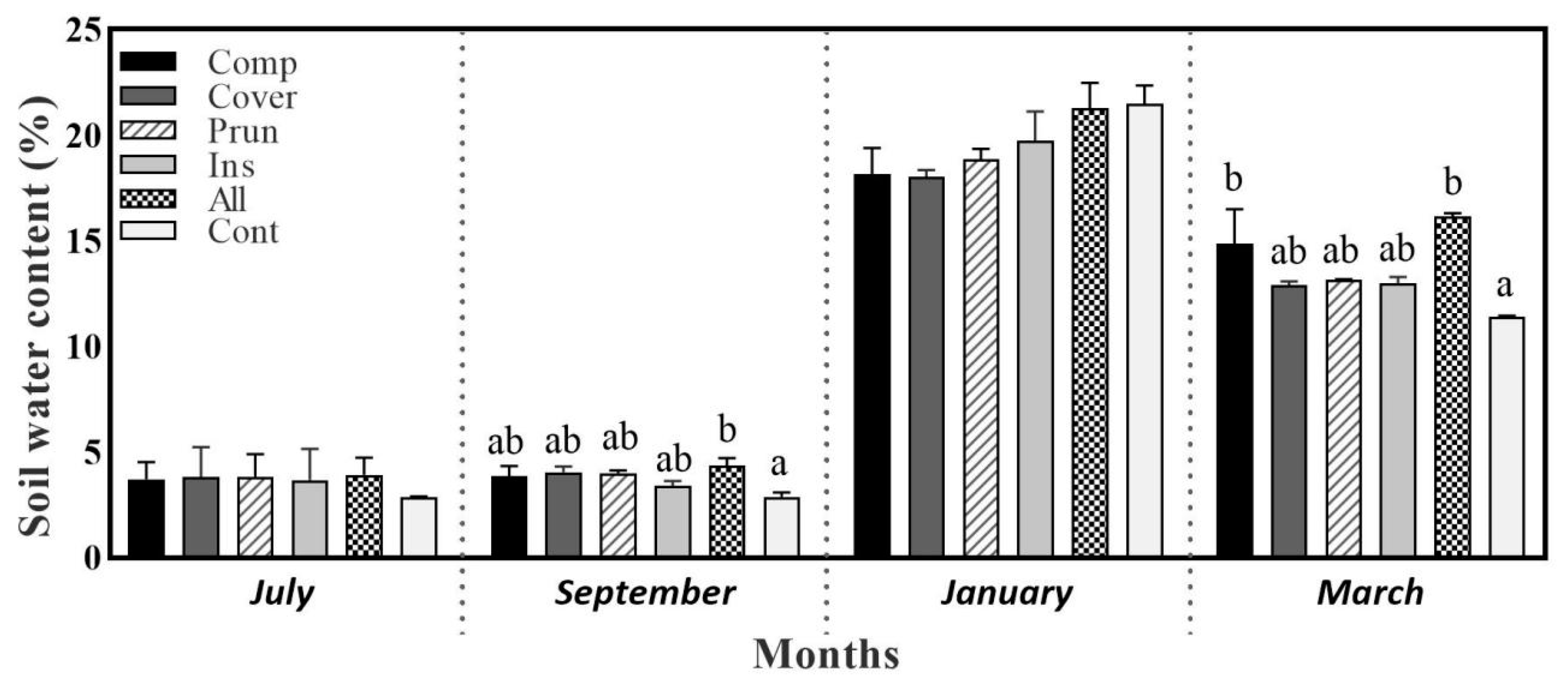
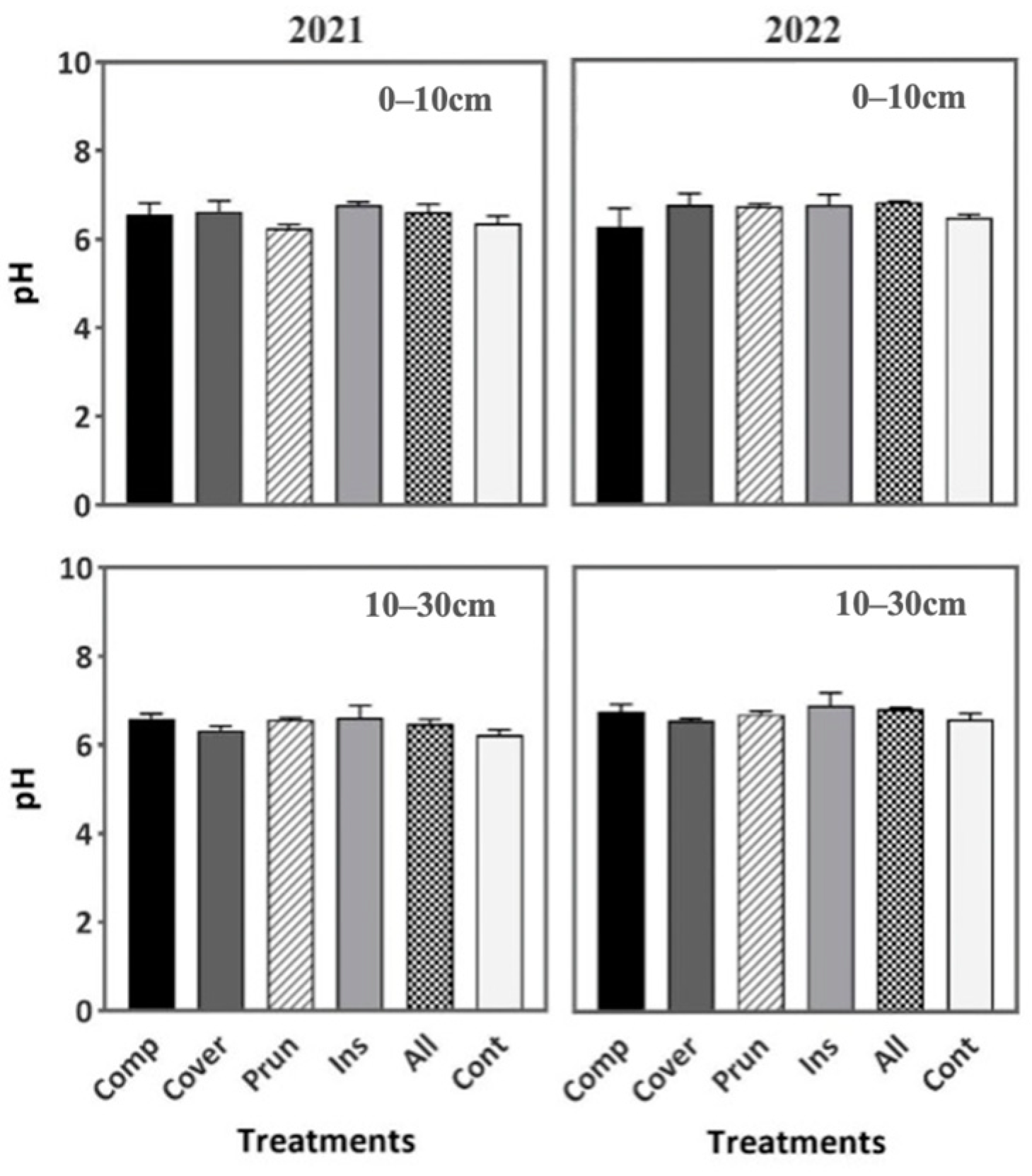
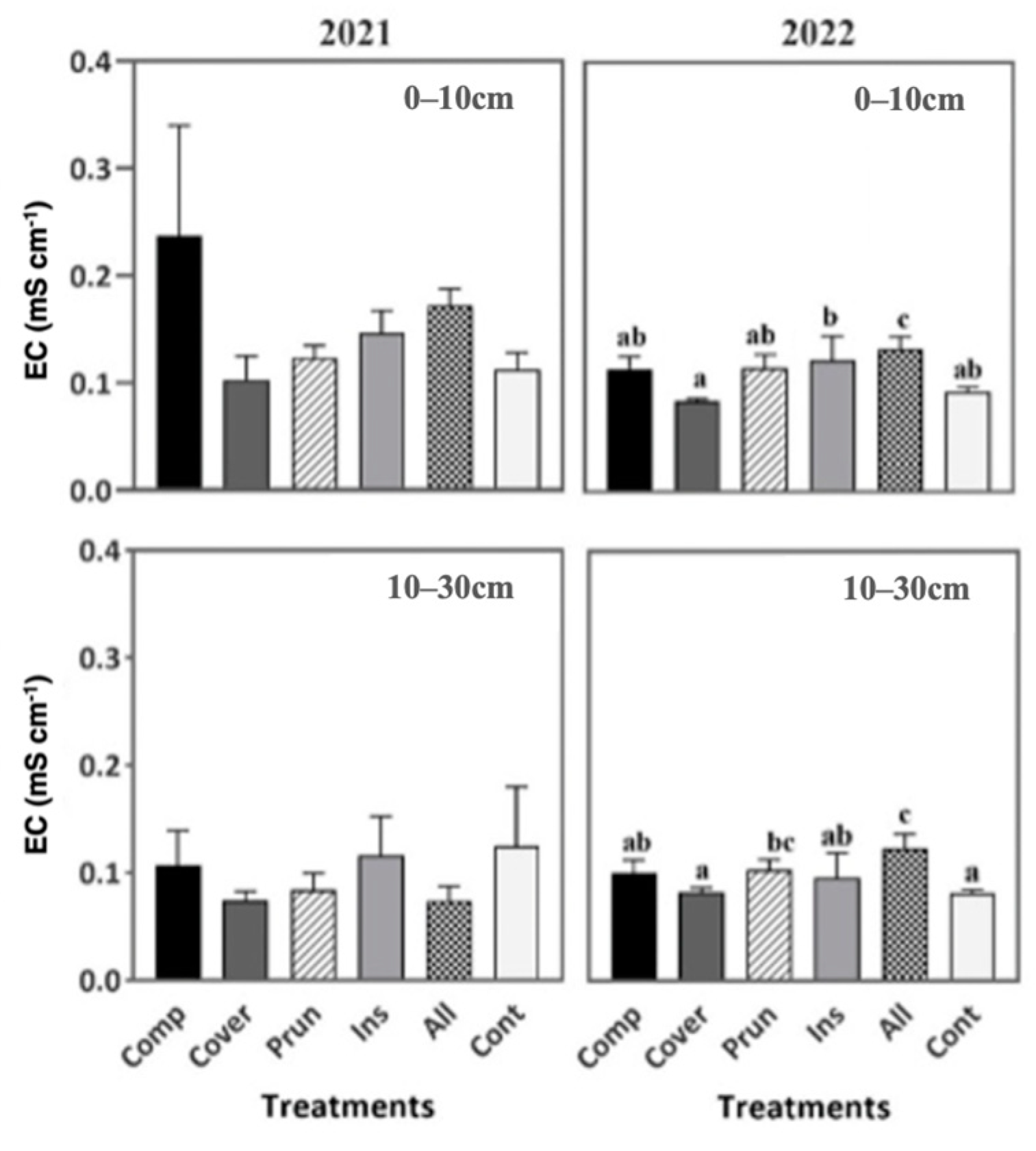
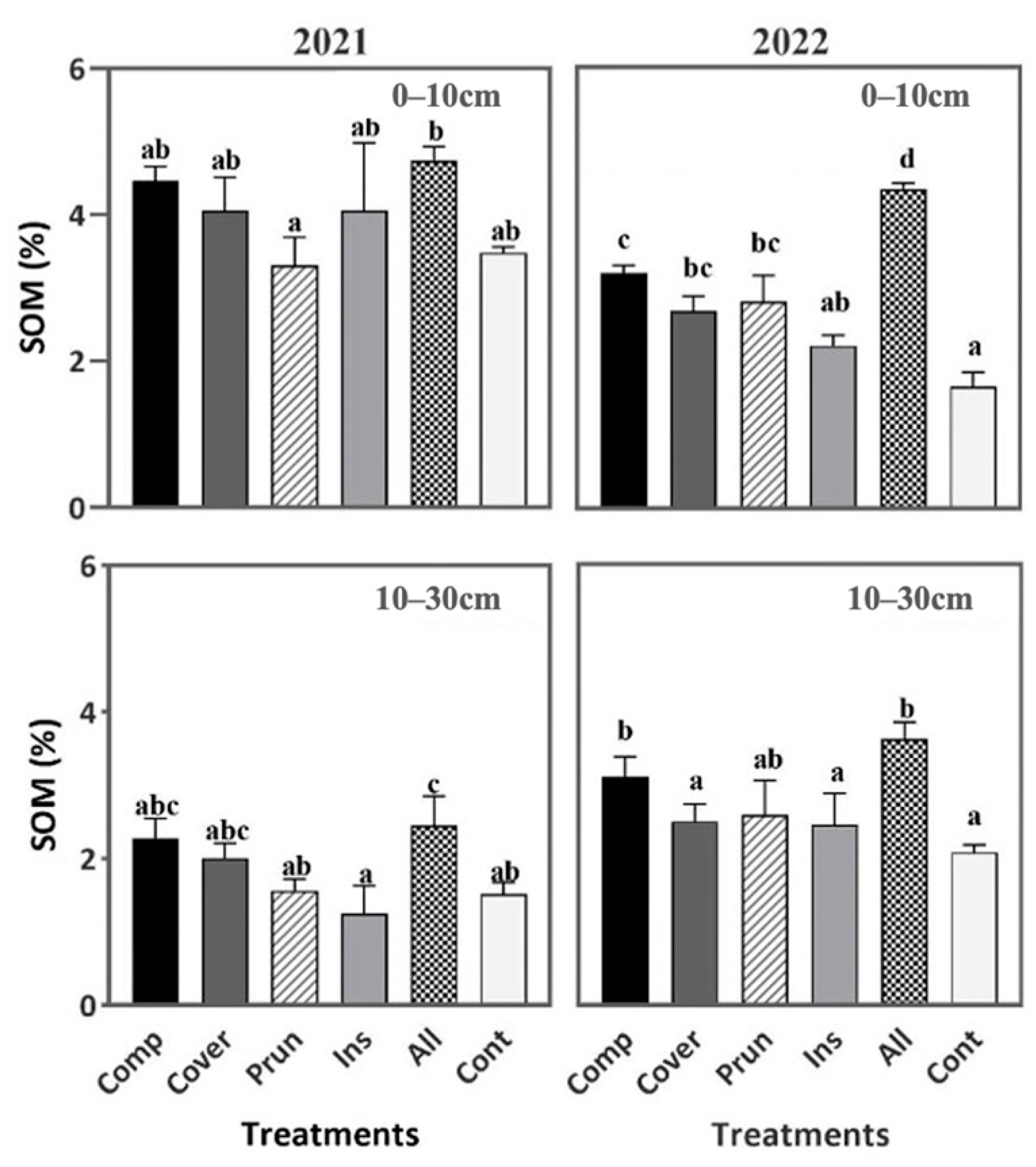
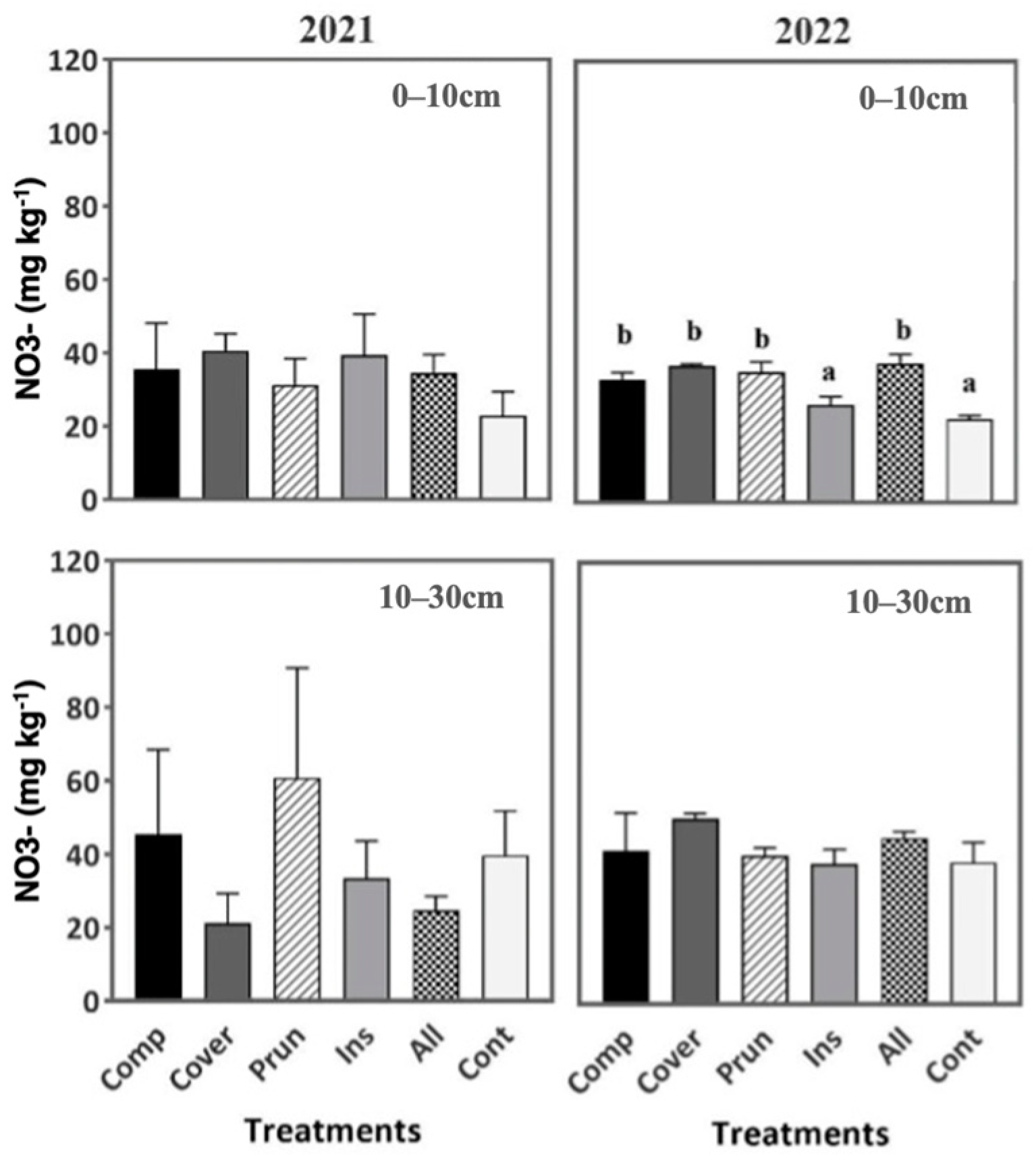
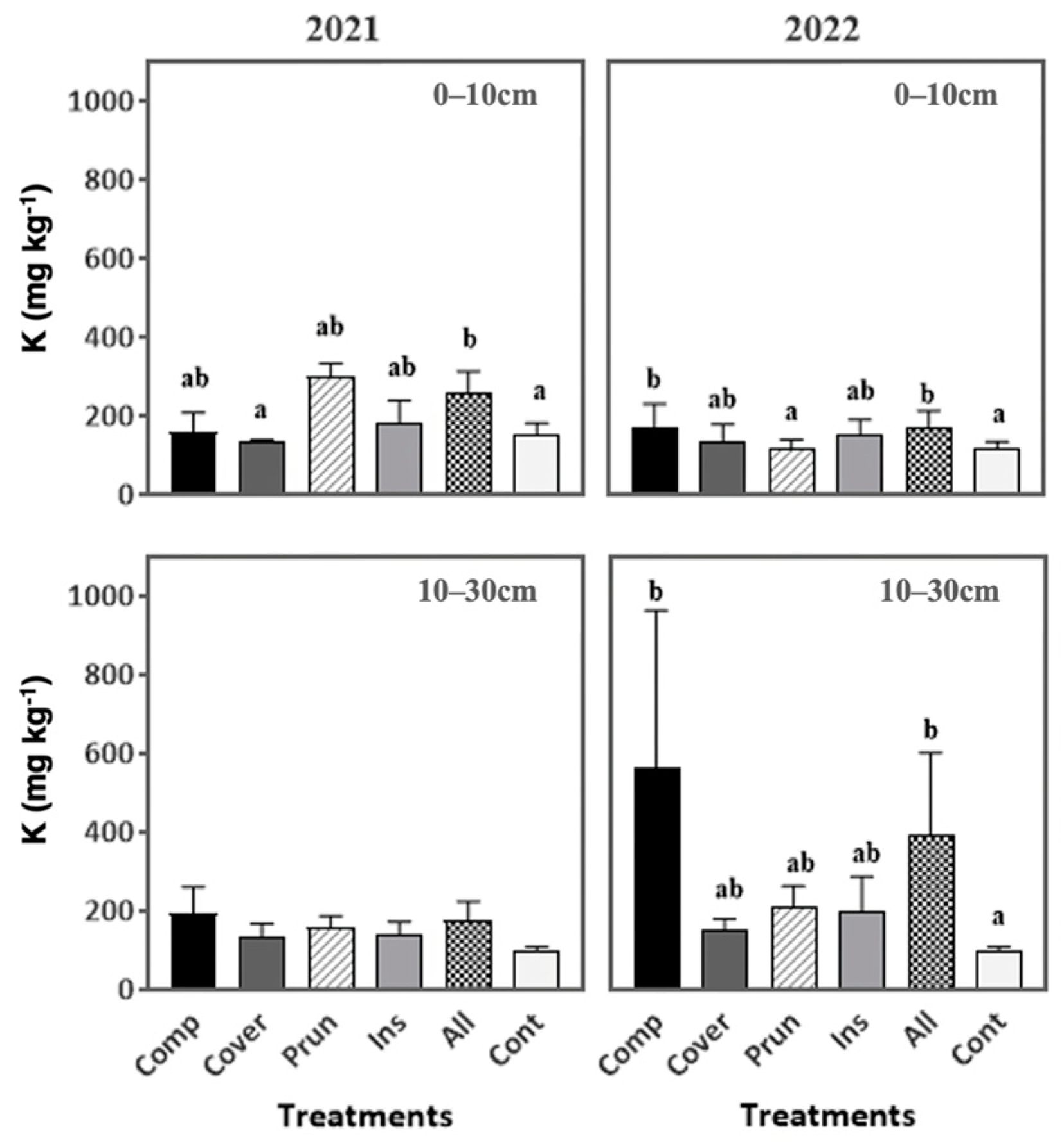
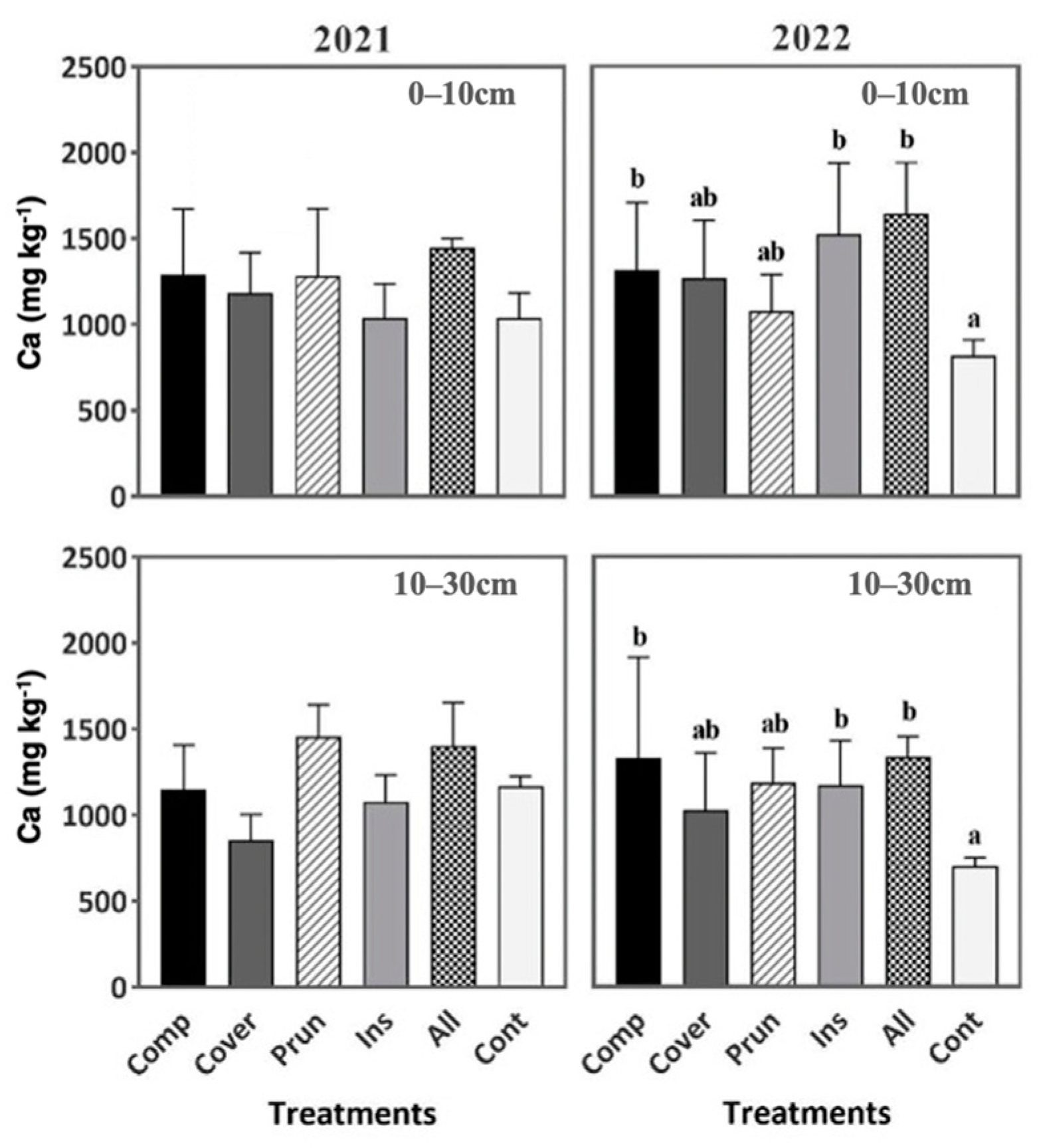
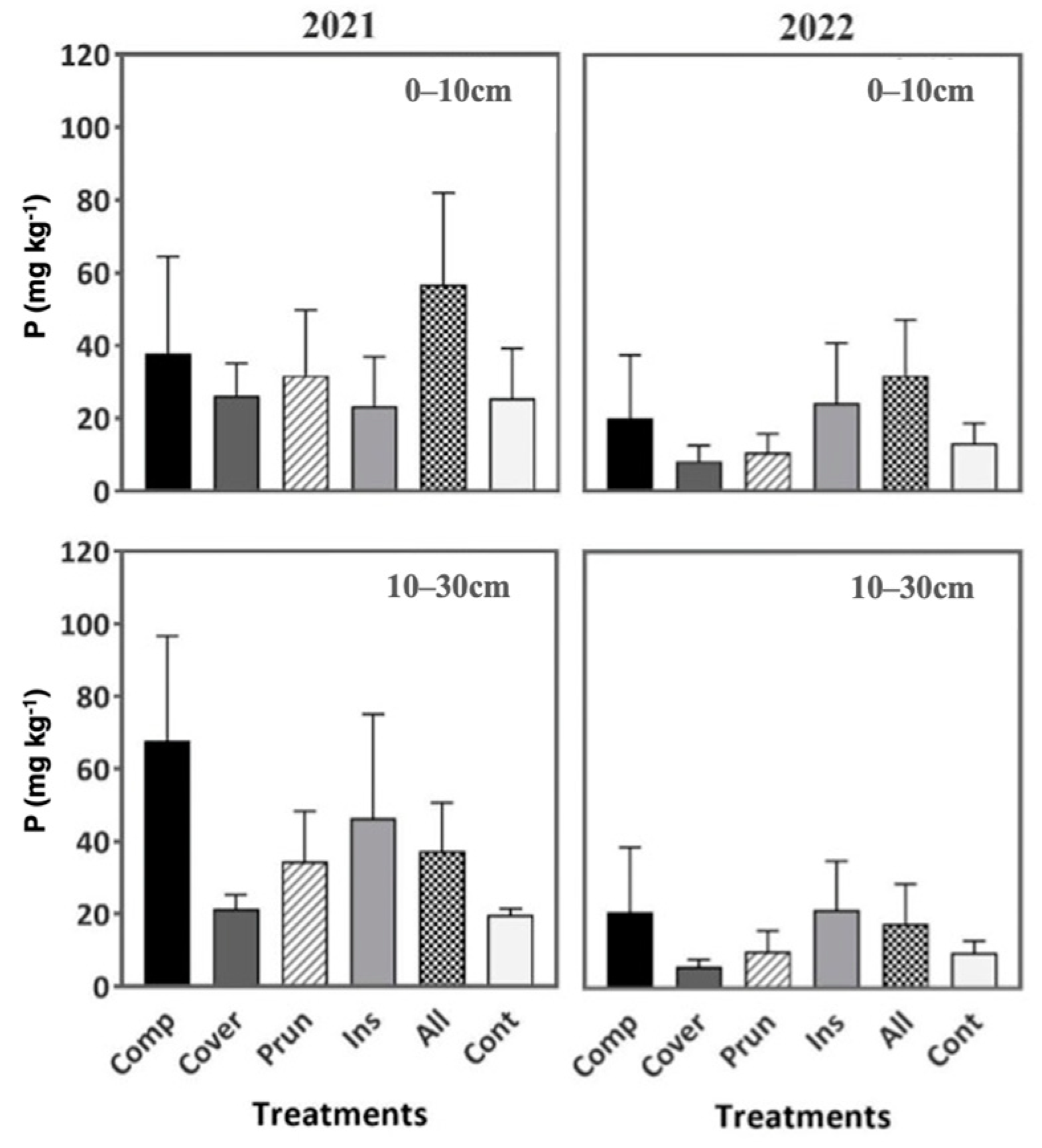
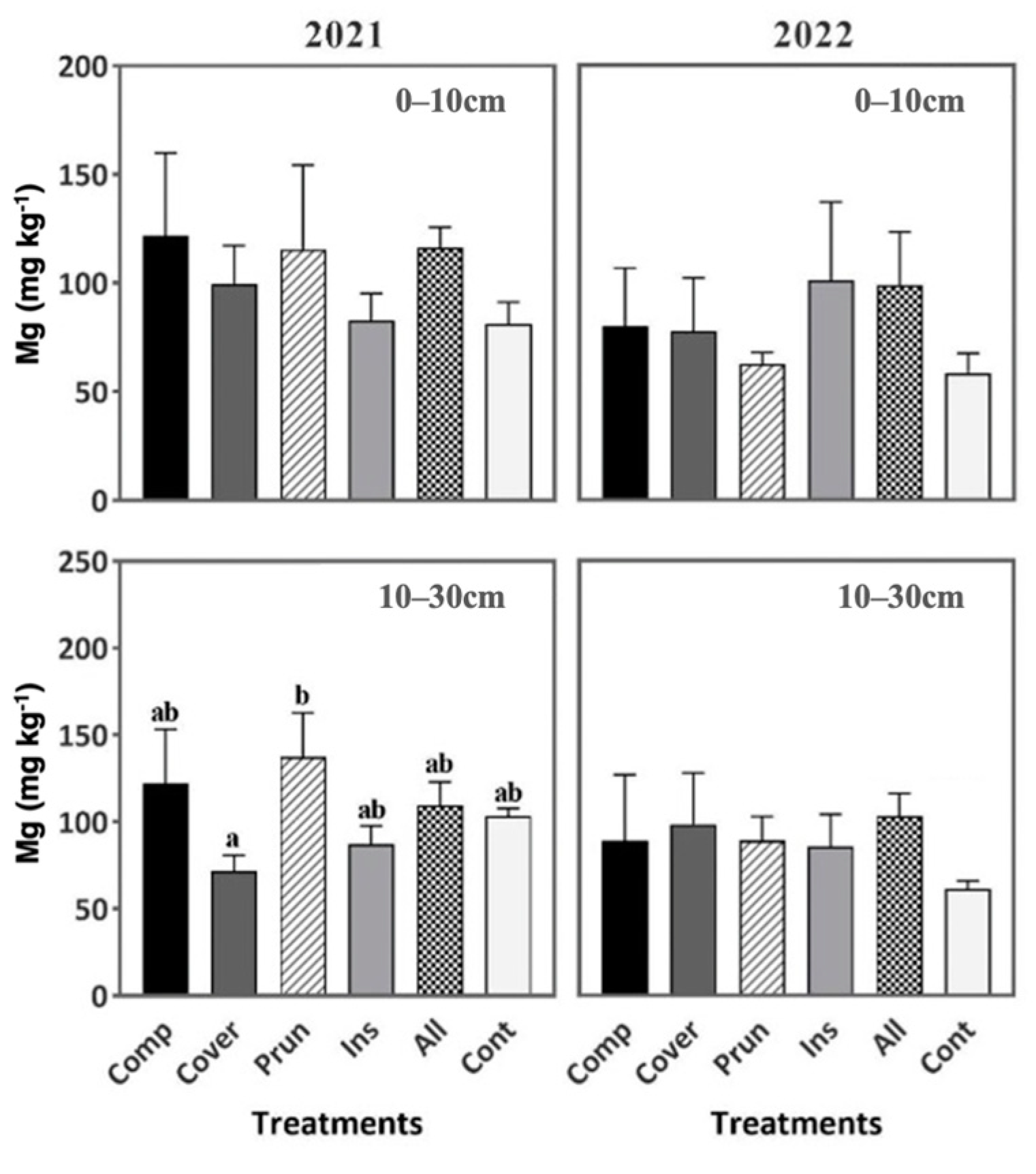
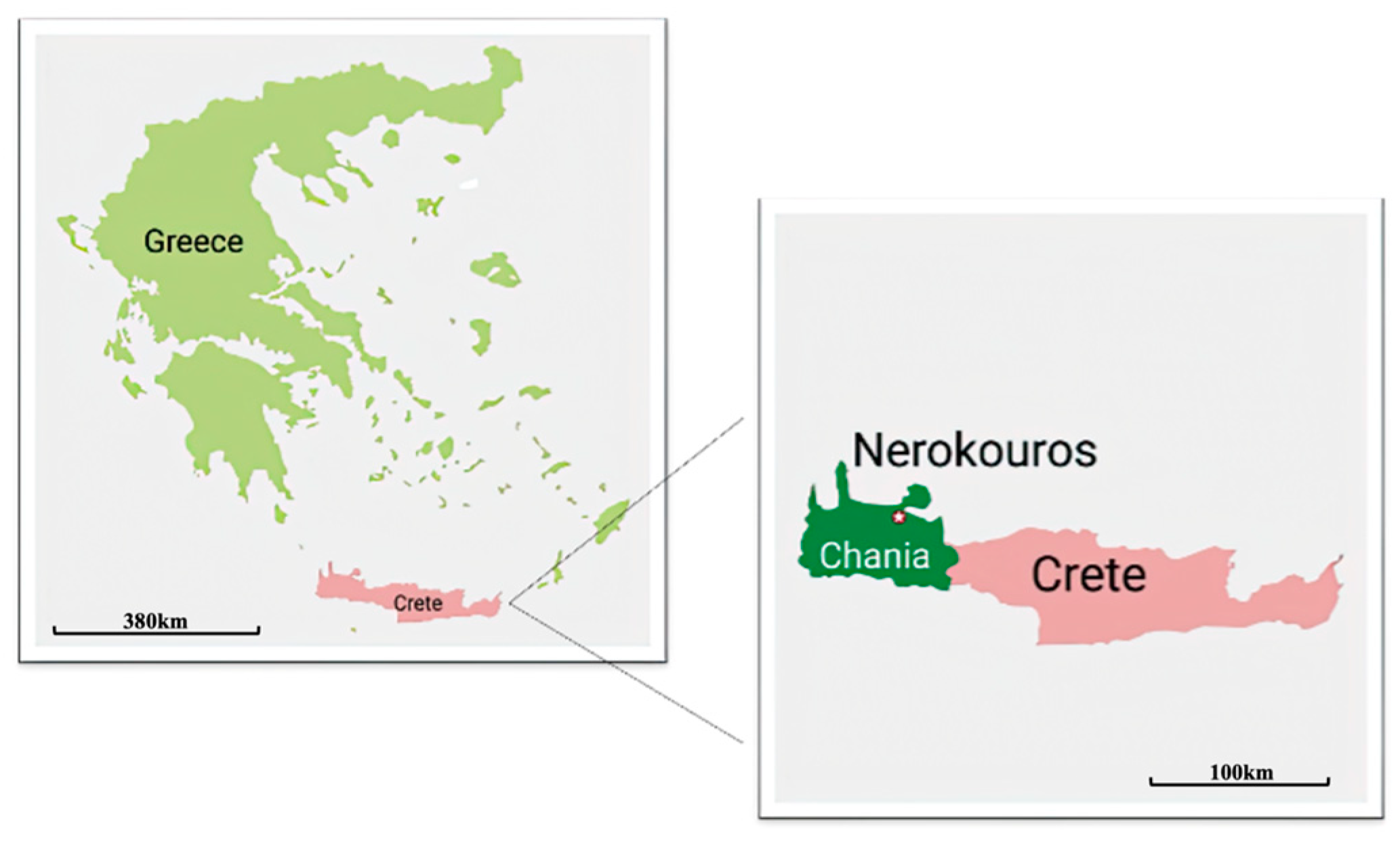
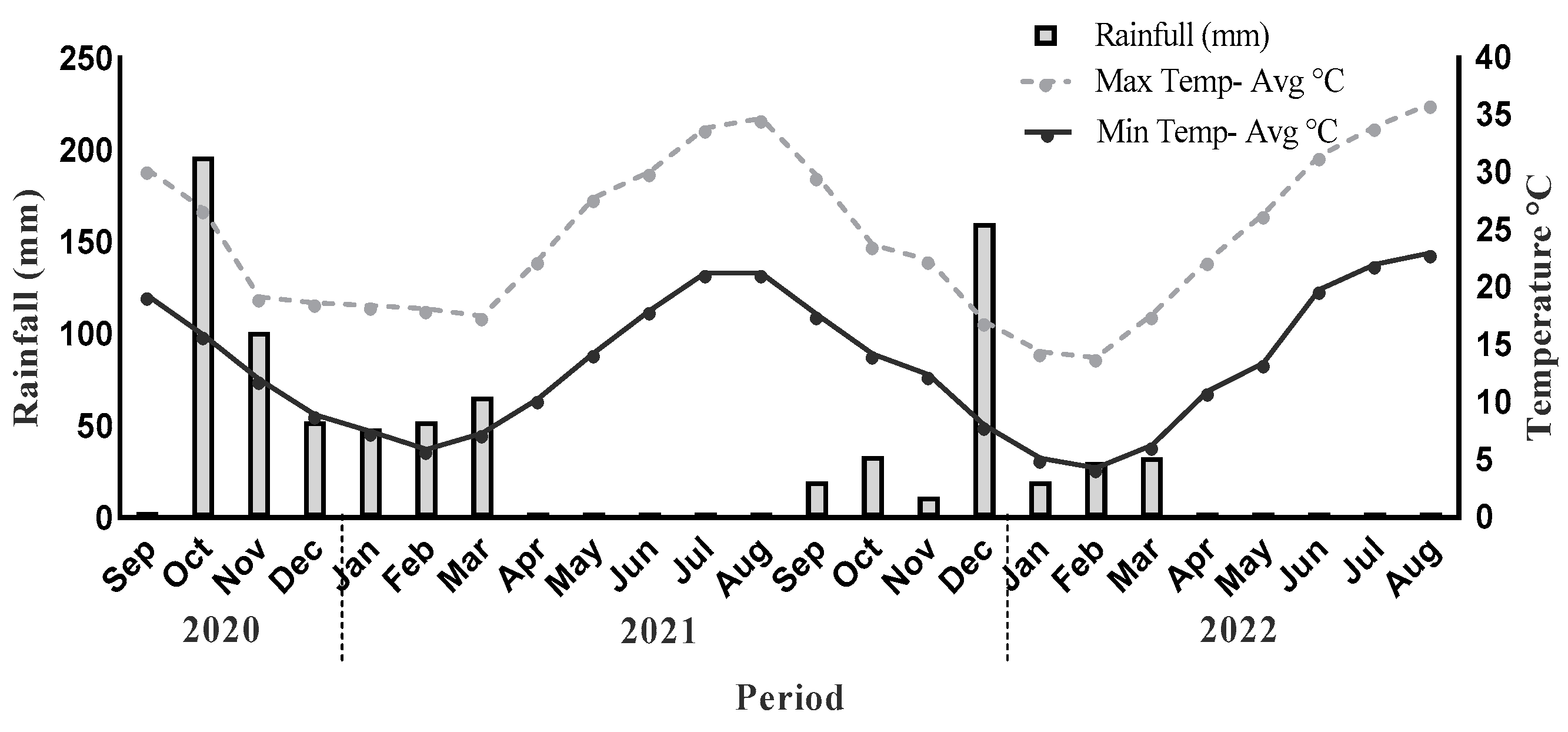
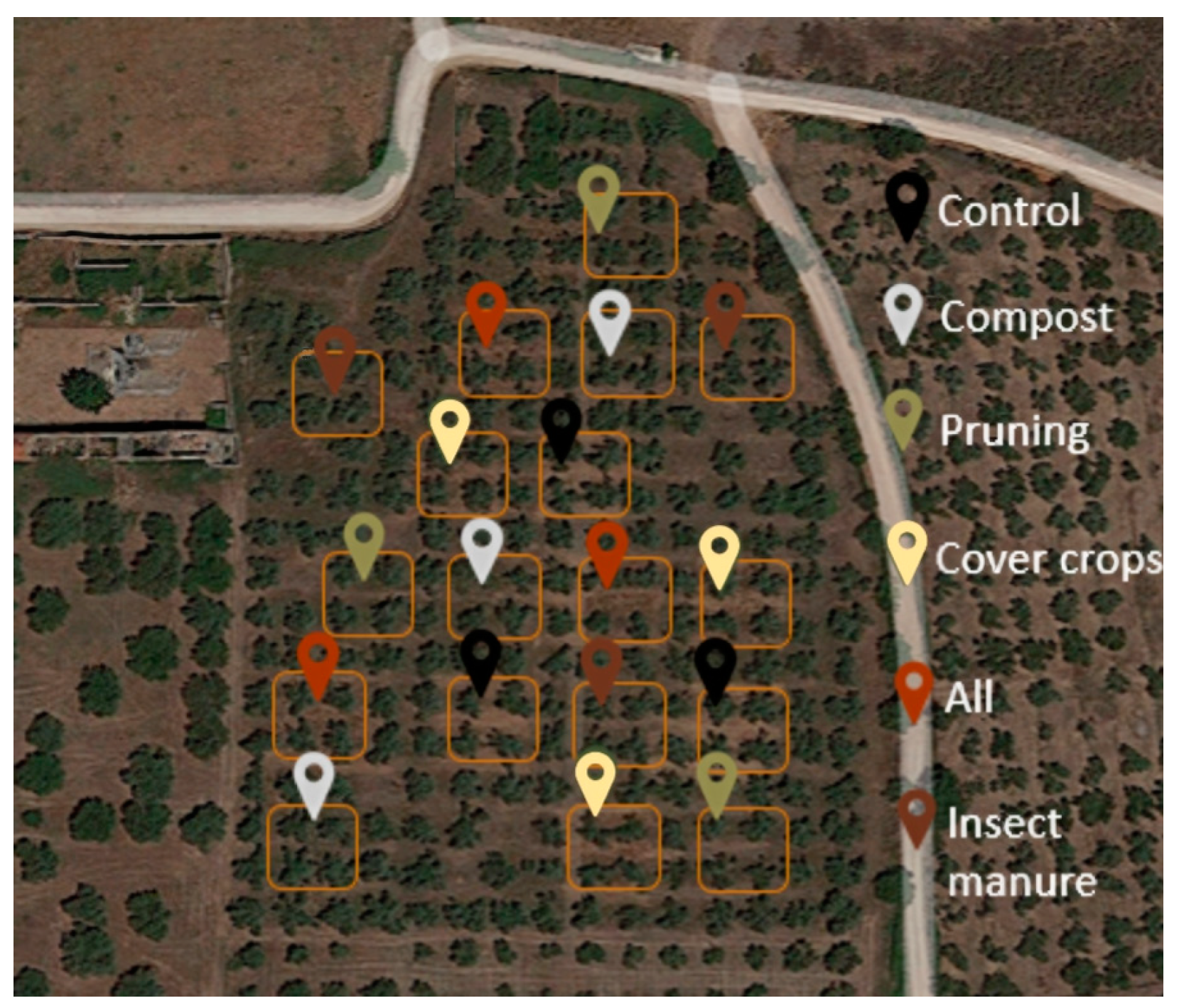
| Treatment | Characteristics | Rate | Date |
|---|---|---|---|
| Compost (Comp) | From olive mill by-products (olive pomace, leaves, and liquid waste mixed with chopped pruning residue) No incorporation into the soil C/N ratio of 18:1; pH of 7.8; contained 49.76% total C, 2.77% total N, 2.26% total K, and 0.18% total P on a dry matter basis | 12.5 t ha−1 7.5 t ha−1 Both as dry matter | December 2020 November 2021 |
| Cover crops (Cover) | A mixture of four annual pasture legumes Pisum sativum subsp. Arvense, Medicago sativa L., Vicia faba L., and Vicia sativa L. and Avena sativa L. as a grain. Seeded manually and incorporated into the soil using a tractor with a rotary tiller pass The vegetation was mechanically managed and left on the ground as mulch after most of the legume seeds reached physiological maturity | 41.65 kg ha−1, 41.65 kg ha−1, 50 kg ha−1, 33.35 kg ha−1, and 25 kg ha−1, respectively | December 2020 December 2021 |
| Pruning residues (Prun) | Chopped pruning residues (leaves and twigs up to 7 cm in diameter) from olive trees of the same grove Added to the soil as they are, as a mulch, without any tillage Contained between 51–55% total C, 0.6–1.8% total N, 0.4–1.2% total K, and 0.05–0.14% total P on a dry matter basis | 11.55 t ha−1 per year (dry weight). | December 2020 December 2021 |
| Insect manure (Ins) | From insect digestates (excreta of Tenebrio molitor fed with organic plants) Insect amendment to the soil without tillage C/N ratio of 10:1; pH of 5.8; contained 80% total C, 2.98% total N, 2.37% total K, and 1.84% total P on a dry matter basis | 1.1 t ha−1 1.2 t ha−1 Both as dry matter | December 2020 December 2021 |
| Comp + Cover + Prun (All) | Involved the application of all the practices described above except the insect manure (compost, pruning residues, and cover crops) in the same plot | The corresponding rate of each treatment’s application rate | The corresponding periods of each treatment’s application date |
| Control (Cont) | Soil tillage with no organic matter additions Soil covered by natural vegetation Receiving only fallen olive-tree leaves and branches. | _ | _ |
| Treatment | Year | Contribution (kg ha−1 year−¹) | ||||
|---|---|---|---|---|---|---|
| Dry Biomass | C | N | P | K | ||
| Compost (Comp) | 2020 2021 | 12,500 7500 | 6220 3732 | 346.25 207.75 | 22.50 13.50 | 282.50 169.50 |
| Cover crops (Cover) | 2020 2021 | 8318 8436 | 2337 2303 | 207.95 227.77 | 24.95 24.46 | 228.70 240.43 |
| Pruning residues (Prun) | 2020 2021 | 11,550 11,550 | 6121 6121 | 124.74 124.74 | 92.40 92.40 | 11.27 11.27 |
| Insect manure (Ins) | 2020 2021 | 1100 1200 | 880 960 | 32.78 35.76 | 20.24 22.08 | 26.07 28.44 |
| Comp + Cover + Prun (All) | 2020 2021 | 32,318 27,436 | 14,678 12,156 | 678.94 560.26 | 139.85 130.36 | 522.47 421.20 |
Disclaimer/Publisher’s Note: The statements, opinions and data contained in all publications are solely those of the individual author(s) and contributor(s) and not of MDPI and/or the editor(s). MDPI and/or the editor(s) disclaim responsibility for any injury to people or property resulting from any ideas, methods, instructions or products referred to in the content. |
© 2024 by the authors. Licensee MDPI, Basel, Switzerland. This article is an open access article distributed under the terms and conditions of the Creative Commons Attribution (CC BY) license (https://creativecommons.org/licenses/by/4.0/).
Share and Cite
Hrameche, O.; Tul, S.; Manolikaki, I.; Digalaki, N.; Kaltsa, I.; Psarras, G.; Koubouris, G. Optimizing Agroecological Measures for Climate-Resilient Olive Farming in the Mediterranean. Plants 2024, 13, 900. https://doi.org/10.3390/plants13060900
Hrameche O, Tul S, Manolikaki I, Digalaki N, Kaltsa I, Psarras G, Koubouris G. Optimizing Agroecological Measures for Climate-Resilient Olive Farming in the Mediterranean. Plants. 2024; 13(6):900. https://doi.org/10.3390/plants13060900
Chicago/Turabian StyleHrameche, Oumaima, Safiye Tul, Ioanna Manolikaki, Nektaria Digalaki, Ioanna Kaltsa, Georgios Psarras, and Georgios Koubouris. 2024. "Optimizing Agroecological Measures for Climate-Resilient Olive Farming in the Mediterranean" Plants 13, no. 6: 900. https://doi.org/10.3390/plants13060900
APA StyleHrameche, O., Tul, S., Manolikaki, I., Digalaki, N., Kaltsa, I., Psarras, G., & Koubouris, G. (2024). Optimizing Agroecological Measures for Climate-Resilient Olive Farming in the Mediterranean. Plants, 13(6), 900. https://doi.org/10.3390/plants13060900








